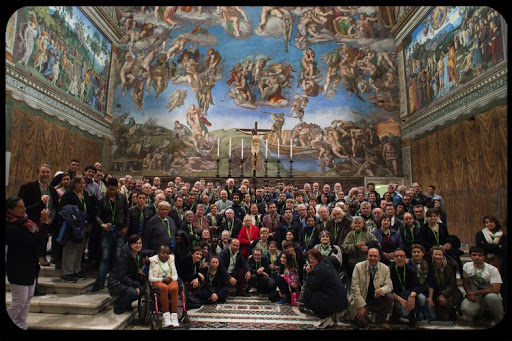St. Lawrence, one of the deacons of Rome in the middle of the third century, was responsible for administering the treasures of the church and distributing alms to the poor. During the persecution under the Emperor Valerian, Lawrence was commanded to bring out the treasures of the church to be confiscated. He famously presented the poor to whom he had been ministering, saying, “Behold in these poor persons the treasures which I promised to show you; to which I will add pearls and precious stones, those widows and consecrated virgins, which are the church’s crown.”
Pope Francis’ invitation to 150 homeless people to enjoy a private tour of the Vatican museums and the Sistine Chapel—ending in a special meal in the museums, was a vivid modern connection with the story of St. Lawrence. Pope Sixtus II authorized St. Lawrence to administer the wealth of the church for the good of the poor, and Pope Francis has authorized his own almoner, Archbishop Konrad Krajewski, to reach out to the needy on the doorstep of the Vatican.
In an interview with ABC, Krajewski described how Francis has redefined the office of papal almoner, "The Holy Father told me at the beginning: ‘You can sell your desk. You don’t need it. You need to get out of the Vatican. Don’t wait for people to come ringing. You need to go out and look for the poor.” Every morning Archbishop Krajewski receives a bundle of letters that the pope has received from people in need. Many of them have a hand-written note from the pope: ”You know what to do," or "Go find them," or "Go talk to them.”
The almoner is not only responsible for helping the poor, but also for raising funds for his work. Archbishop Krajewski’s main source of revenue is the sale of certificates commemorating a special papal blessing. The hand-made certificates celebrate a papal blessing that the pope bestows on the occasion of a wedding, baptism or priestly ordination. The beautiful personalized certificate includes a picture of Pope Francis and an apostolic blessing written in calligraphy. All proceeds go to Krajewski’s work with the poor, and he indicates that the popularity of the papal blessings has doubled in recent years.
With that income Krajewski has taken practical, creative steps to help the poor. Roman barbers volunteer their time to provide shaves and haircuts to the homeless. Showers and toilets have been set up for those who live on the streets. The latest initiative, to give the homeless a tour of the Vatican museums, culminating in the Sistine Chapel and a personal meeting with the pope, has not only won hearts, but put the Church’s relationship to wealth and poverty into perspective.
Private tours of the Vatican museums take place all the time. However, one gets the impression that such tours are reserved for the privileged—visiting academics, political leaders, wealthy donors or important cultural figures. By inviting the homeless on such a tour Pope Francis reminds the world that the historical and artistic treasures of the Vatican are not only for the rich and powerful.
The pope’s gesture also reminds the world of the proper relationship to wealth and poverty. So often one hears comments like, “If the pope really cares for the poor, why doesn’t he sell all that fancy artwork and give the money to the needy?” When a parish plans to build a beautiful new church grumbles are sometimes heard: “Why are they spending so much money on a building when they could give the money to the poor?” That, of course, is the argument Judas made, and Jesus reminds us in the gospel that “the poor you will have with you always." By his concern for the poor, Pope Francis shows us what the riches of the church are for: they are to enrich all Catholics—indeed the whole world with the beauty, truth and goodness of the Catholic faith.
The beautiful buildings, historic artwork, and priceless treasures of the church are part of an ancient patrimony: one of immense importance to the whole world. The Vatican treasures are held in trust for all people, rich and poor alike. The point was made recently when someone complained about a beautiful church being built in a poor part of town. The project was defended by one of the donors who said, “Why should the poor be given a mean and ugly church in which to worship?”
Finally, by welcoming the homeless into the Sistine Chapel Pope Francis brought alive once again the ancient story of St. Lawrence. As he posed for photographs with the homeless within the splendor of Michelangelo’s masterpiece, Pope Francis was saying to the world, “Here I present to you the true treasures of the church, for in the poor and homeless you will find the treasure which is Christ the Lord."
Join Fr Dwight Longenecker, Johnette Benkovic and Steve Wood in Greenville, SC on April 11 and 12 for Divine Mercy Weekend. More information at divinemercysc.org

